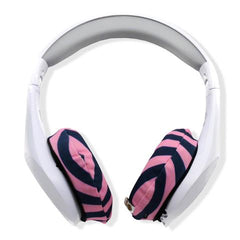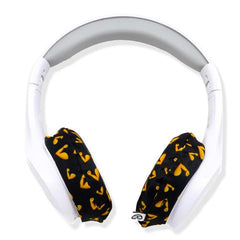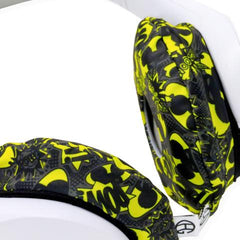The World Health Organisation Lists Headphone Noise as 'Potentially Harmful'

The World Health Organisation (WHO) has updated its guidelines on harmful noise levels and included “leisure noise” for the first time. Leisure noise includes the volume in nightclubs, fitness classes, concerts, sporting events and from headphones.
The WHO’s guidelines suggest that 1 in 5 Europeans are regularly exposed to noise levels that could seriously damage their health. Unsurprisingly, road traffic is one of the biggest concerns, but it’s worrying to see that the World Health Authority now considers noise from personal devices to be as dangerous as volume levels at live sporting events and concerts.
Loud noise is linked to cardiovascular disease, sleep deprivation, high blood pressure and an increased risk of stroke. Noise pollution puts our bodies on edge and it stresses us out, and it’s worth understanding, too, that we can’t always shut a window or close a door to noise. It can be everywhere; it often is everywhere and in ways that we may no longer even notice or in ways that we enjoy too much to turn down or stop listening to.

Leisure noise is something you may at first associate with those on the outside of an event or venue: the homeowners living next to a stadium, the bleed from someone else’s headphones, the restaurant underneath a gym BUT it’s the situations that we put ourselves in as revellers, class members, supporters, users and fans that is also a concern to the World Health Organisation. It’s the things we engage with for pleasure: the big gig or musical concert; it’s the atmosphere in a stadium during a game or the bass at the aerobics class. If you were to remove or reduce the sound in any of those situations, it would ruin the event entirely.
Far from trying to get away from leisure noise, we’re often pushing to get closer. You’d quickly walk away from a jet engine or chainsaw, but you’d probably be less inclined to ask a DJ to turn down a banging 90s tune. And leisure noise can be dangerous in the gym where ambient sound can often be THE WORST. It makes sense that we’d pop on our headphones to cut out the distractions and focus on our workout.
So How is Leisure Noise Damaging Our Health
Loud noises can permanently damage our hearing. You wouldn’t walk into a gun firing range without ear defenders BUT you’d probably stick headphones into a personal device and ratchet the sound up. You’d be surprised how quickly hearing can be damaged simply by pushing the volume on your headphones up to the maximum. It’s one reason why the WHO is so concerned. “More than one billion teenagers and young adults are at risk of hearing loss due to their personal devices”
That’s pretty terrifying.
The Metro has rather unfairly labelled the WHO’s guidelines as the “fun police”, but it’s hard to accuse the WHO of overreacting. We’re all gunning the volume control to cut out ambient noise, aren’t we? Especially those of us who have crappy it-came-free-with-my-phone earbuds. It’s up to individuals to take personal responsibility for how loudly they’re listening to their music, but how many of us really understand the risks we’re taking when we plug into our devices? You can’t reverse damage to your hearing. You can only stop it from getting worse.
The recommendation is that Leisure noise should be kept at 70 decibels for headphones. Anything over 85 for prolonged periods of time is dangerous. If you’re listening to anything over 100 decibels then you should restrict your usage to 15 minutes. But everyone is different with differing levels of tolerance so it’s hard to pinpoint an exact rule. It’s worth knowing, however, that standard headphones can emit sounds of 110 decibels if turned all the way up. If these numbers are making you feel uncomfortable, then you’re not the only one. Our focus in the gym has to be about more than just our workout and how we get it done.
We’re out buying our premium brand headphones, our fancy foldaway cases, our sweat-proof headphone covers and streaming subscriptions, but we’re not paying half as much attention to how high the volume is on our phones and what damage we could be doing to ourselves.
That the WHO has had to step in and begin to address headphone noise cannot be overstated: it’s a serious problem.

One potential solution could be to invest in a pair of good quality noise-cancelling headphones. By blocking out ambient sounds, noise-cancelling headphones won’t have you turning up the volume as readily as you otherwise might. They’re particularly useful in the gym, on flights or on public transport. Last year, The Guardian wrote about how there are a number of people now, in cities like London where noise pollution is traditionally very high, wearing noise-cancelling headphones without any sound: sometimes people just want to the world around them to get a little quieter.
Even without active-noise-cancelling, a good pair of premium headphones will offer some form of passive noise-cancelling effect but it’s still important to be mindful about how high the volume is going.
And whilst the WHO has used the term headphone, this isn’t just a problem that’s limited to over-ear or on-ear headphones as things are often worse with in-earphones or earbuds as the speaker sits inside the ear canal.
How Can I Reduce the Risk of Hearing Loss with Headphones
-
Use noise cancelling headphones. The industry leader for noise-cancelling technology has always been BOSE but there is a wide selection of other headphones available including Sony, Sennheiser and the soon-to-be-released Microsoft Surface.
-
If you can’t get noise-cancelling headphones, then over-the-ear ‘phones will offer some measure of passive noise cancellation.
-
Don’t listen at more than 60% of the maximum volume.
-
Don’t listen for more than an hour in one go without a 5-minute break
-
Check how loud you’re listening to your music regularly. Many websites advise that if you take your headphones off your ears, hold them at arm's length and still hear sounds, then they’re probably too loud.
-
Invest in a quality pair. This isn’t a hard-and-fast rule but thicker cushions and better design will automatically help reduce ambient sounds even if there’s no active noise-cancelling tech.
-
Use a limiter on your phone if you have one. This will stop you increasing volume mindlessly.
- You could also consider doing some of your exercising without headphones. This could be a hard thing to do for a number of us BUT it’s worth persevering with and might be better for your focus and safer if you do.
Are you guilty of having your sound too loud? Are you less likely to listen at high volumes now the WHO has listed it as potentially harmful? Drop us a comment below.
And don't forget! Protect your hearing and protect your headphones. Ear Hugz are sweat-proof antibacterial headphone covers in a range of awesome designs.





